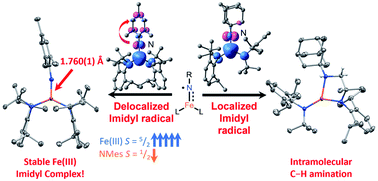Stabilization of a high-spin three-coordinate Fe(iii) imidyl complex by radical delocalization†
Abstract
High-spin, late transition metal imido complexes have attracted significant interest due to their group transfer reactivity and catalytic C–H activation of organic substrates. Reaction of a new two-coordinate iron complex, Fe{N(tBu)Dipp}2 (1, Dipp = 2,6-diisopropylphenyl), with mesitylazide (MesN3) afforded a three-coordinate Fe–imidyl complex, Fe{N(tBu)Dipp}2(![[double bond, length as m-dash]](https://www.rsc.org/images/entities/char_e001.gif) NMes) (2). X-ray crystallographic characterization of single crystals of 2 showed a long Fe–N distance of 1.761(1) Å. Combined magnetic and spectroscopic (Mössbauer and X-ray absorption near edge structure spectroscopy, XANES) characterization of 2 suggests that it has an S = 2 ground state comprising an S = 5/2 Fe(III) center antiferromagnetically coupled to an S = 1/2 imidyl ligand. Reaction of 1 and 1-azidoadamantane (AdN3) generated a putative, transient Fe{N(tBu)Dipp}2(
NMes) (2). X-ray crystallographic characterization of single crystals of 2 showed a long Fe–N distance of 1.761(1) Å. Combined magnetic and spectroscopic (Mössbauer and X-ray absorption near edge structure spectroscopy, XANES) characterization of 2 suggests that it has an S = 2 ground state comprising an S = 5/2 Fe(III) center antiferromagnetically coupled to an S = 1/2 imidyl ligand. Reaction of 1 and 1-azidoadamantane (AdN3) generated a putative, transient Fe{N(tBu)Dipp}2(![[double bond, length as m-dash]](https://www.rsc.org/images/entities/char_e001.gif) NAd) (3′) complex that yielded an intramolecular C–H amination product, Fe{N(tBu)Dipp}{κ2-N,N′-
NAd) (3′) complex that yielded an intramolecular C–H amination product, Fe{N(tBu)Dipp}{κ2-N,N′-![[- with combining low line]](https://www.rsc.org/images/entities/char_002d_0332.gif) N(CMe2CH2
N(CMe2CH2![[- with combining low line]](https://www.rsc.org/images/entities/char_002d_0332.gif) NHAd)Dipp} (3). Quantum mechanical calculations further confirmed the spectroscopic assignment of 2 and 3′, as well as the differences in their stability and reactivity. Importantly, imidyl radical delocalization onto the mesityl ring significantly increased the stability of 2 and reduced its reactivity toward potential hydrogen atom transfer (HAT) reagents. In contrast, quantum mechanical calculations of 3′ revealed that the radical was solely localized on the imidyl N, leading to a high reactivity toward the proximal C–H bond of the N(tBu)Dipp− ligand.
NHAd)Dipp} (3). Quantum mechanical calculations further confirmed the spectroscopic assignment of 2 and 3′, as well as the differences in their stability and reactivity. Importantly, imidyl radical delocalization onto the mesityl ring significantly increased the stability of 2 and reduced its reactivity toward potential hydrogen atom transfer (HAT) reagents. In contrast, quantum mechanical calculations of 3′ revealed that the radical was solely localized on the imidyl N, leading to a high reactivity toward the proximal C–H bond of the N(tBu)Dipp− ligand.



 Please wait while we load your content...
Please wait while we load your content...